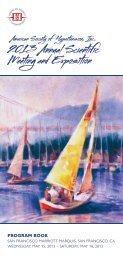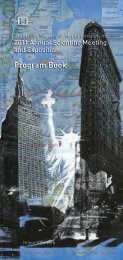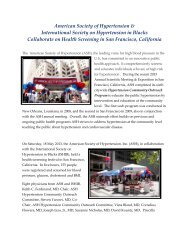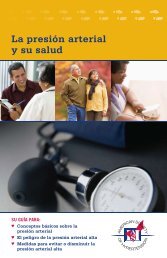2010 Annual Scientific Meeting and Exposition 2010 Annual ...
2010 Annual Scientific Meeting and Exposition 2010 Annual ...
2010 Annual Scientific Meeting and Exposition 2010 Annual ...
You also want an ePaper? Increase the reach of your titles
YUMPU automatically turns print PDFs into web optimized ePapers that Google loves.
As with other drugs that block angiotensin II or its effects, concomitant use ofpotassium sparing diuretics (e.g., spironolactone, triamterene, amiloride), potassiumsupplements, or salt substitutes containing potassium may lead to increasesin serum potassium <strong>and</strong> in heart failure patients to increases in serum creatinine.8 USE IN SPECIFIC POPULATIONS8.1 PregnancyPregnancy Category D [see Warnings <strong>and</strong> Precautions (5.1)].Valturna contains both aliskiren (a direct renin inhibitor) <strong>and</strong> valsartan (an angiotensinII receptor blocker). When administered during the second or third trimesterof pregnancy, drugs that act directly on the renin-angiotensin-aldosterone systemcan cause fetal <strong>and</strong> neonatal morbidity <strong>and</strong> death. Valturna can cause fetalharm when administered to a pregnant woman. If this drug is used during pregnancy,or if the patient becomes pregnant while taking this drug, apprise thepatient of the potential hazard to the fetus.Angiotensin II receptor antagonists, like valsartan, <strong>and</strong> angiotensin-convertingenzyme (ACE) inhibitors exert similar effects on the renin-angiotensin-aldosteronesystem. In several dozen published cases, ACE inhibitor use during the second<strong>and</strong> third trimesters of pregnancy was associated with fetal <strong>and</strong> neonatal injury,including hypotension, neonatal skull hypoplasia, anuria, reversible or irreversiblerenal failure, <strong>and</strong> death. Oligohydramnios was also reported, presumably fromdecreased fetal renal function. In this setting, oligohydramnios was associatedwith fetal limb contractures, craniofacial deformation, <strong>and</strong> hypoplastic lungdevelopment. Prematurity, intrauterine growth retardation, <strong>and</strong> patent ductusarteriosus were also reported, although it is not clear whether these occurrenceswere due to exposure to the drug. In addition, first trimester use of ACE inhibitors,a specific class of drugs acting on the renin-angiotensin-aldosterone system,has been associated with a potential risk of birth defects in retrospective data.When pregnancy occurs in a patient using Valturna, discontinue Valturna treatmentas soon as possible. Inform the patient about potential risks to the fetusbased on the time of gestational exposure to Valturna (first trimester only orlater). If exposure occurs beyond the first trimester, perform an ultrasoundexamination.In rare cases when another antihypertensive agent cannot be used to treat thepregnant patient, perform serial ultrasound examinations to assess the intraamnioticenvironment. Routine fetal testing with non-stress tests, biophysicalprofiles, <strong>and</strong>/or contraction stress tests may be appropriate based on gestationalage <strong>and</strong> st<strong>and</strong>ards of care in the community. If oligohydramnios occurs in thesesituations, individualized decisions about continuing or discontinuing Valturnatreatment <strong>and</strong> about pregnancy management should be made by the patient, herphysician, <strong>and</strong> experts in the management of high risk pregnancy. Patients <strong>and</strong>physicians should be aware that oligohydramnios may not appear until after thefetus has sustained irreversible injury.Closely observe infants with histories of in utero exposure to Valturna for hypotension,oliguria, <strong>and</strong> hyperkalemia. If oliguria occurs, these infants may requireblood pressure <strong>and</strong> renal perfusion support. Exchange transfusion or dialysismay be required to reverse hypotension or support decreased renal function.No reproductive toxicity studies have been conducted with the combination ofaliskiren <strong>and</strong> valsartan. However, these studies have been conducted foraliskiren as well as valsartan alone [see Nonclinical Toxicology (13) in the fullprescribing information].8.3 Nursing MothersIt is not known whether aliskiren is excreted in human milk, but aliskiren wassecreted in the milk of lactating rats. It is not known whether valsartan is excretedin human milk. Valsartan was excreted into the milk of lactating rats; however,animal breast milk drug levels may not accurately reflect human breast milk levels.Because of the potential for adverse effects on the nursing infant, a decisionshould be made whether to discontinue nursing or discontinue the drug, takinginto account the importance of the drug to the mother.8.4 Pediatric UseSafety <strong>and</strong> effectiveness of Valturna in pediatric patients have not been established.









